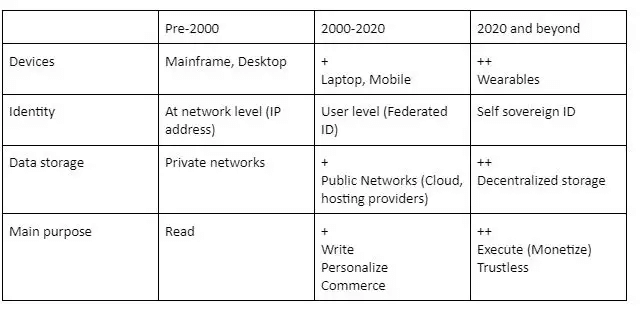The future is Blockchain, and now is the time to seize its potential.
Imagine a world where money flows effortlessly, escaping from the constraints of traditional financial systems. With Blockchain development solutions, transactions become lightning-fast, eliminating those pesky fees that weigh you down. Take control of your financial destiny as you embrace a digital wallet that knows no bounds. No more waiting for permissions or worrying about interference—your money, your rules.
Blockchain is more than just a buzzword—it’s a transformative force reshaping industries. By 2022, corporate investments in Blockchain are estimated to reach a staggering US$12.4 billion. It’s a technology that goes beyond cryptocurrencies, offering a decentralized, transparent, and secure foundation for various applications.
In this insightful guide, we unravel the complexities of Blockchain development, drawing parallels to the groundbreaking days of the internet. Are you prepared to uncover the secrets behind Blockchain technology, how it works, and most importantly, why it matters in the digital world?
This blog has all the answers you need!
It will provide you with a clear understanding of the complexities of Blockchain. Thus, you’ll be able to stay updated and make informed decisions about the technical modifications while having intellectual conversations about this transforming tech.
As Blockchain reshapes various industry verticals and paves the path for a borderless and empowered society, the future beckons with boundless possibilities. So buckle in for an exciting journey as we dissect Blockchain and reveal its incredible possibilities.
But what exactly is Blockchain?
Let’s find out!
What is Blockchain Technology?
Blockchain technology is transforming the practice of recording information by ensuring its integrity and security. At its core, Blockchain is a digital ledger that records transactions across a network of computers. It offers a timeless and transparent record of information, resistant to tampering, hacking, and manipulation.
Imagine this scenario – a shared Google spreadsheet accessible to numerous computers in a network. In this digital ledger, transactional records are stored based on real purchases. What makes Blockchain fascinating is that while anyone can view the data, it remains incorruptible.
Blockchain technology has a decentralized nature which eliminates the need for a central authority, thus making it more secure and transparent. Each transaction is verified by multiple participants, ensuring unity and preventing fraudulent activities.
With such convincing functionalities, it is definitely a game-changer for industries like finance, supply chain management, healthcare, and various other sectors.
What’s Behind the Popularity of Blockchain?
Over the past few decades, the internet’s potential has captivated and sparked debates. Advancing technology has transformed it into a universal medium for communication, commerce, and entertainment. However, there is still so much to be reimagined and explored. Every transformation has made hardware more personalized, and the internet has created more real-world utilities, changing how we work and live.
Today, Blockchain technology is fueling another wave of transformation and empowering scenarios that were not imaginable before.

Uses of Blockchain Technology
1. Supply Chain
Blockchain is being used in supply chain areas such as food distribution, furniture manufacturing, software development, and the mining of precious commodities such as diamonds.
2. Smart Contracts
Smart contracts are proposed contracts that are digital and run on the Blockchain. They can be enforced or carried out without involving humans. The Blockchain development services eliminates the need for an intermediary between two contracting parties. As a result, it provides transaction automation and reduces inter-party friction.
3. Video Games/Art
Have you heard of the Crypto Kitties? It was a game launched on the decentralized Ethereum Blockchain platform. One of the game’s virtual pets was sold for more than $100,000.
4. Healthcare
As per the Wall Street Journal, Ernest & Young has been leveraging Blockchain app development services in order to assist airlines, government agencies, employers and others in tracking people who were immune to Coronavirus and those who went through antibody tests. China used Blockchain technology to increase health insurance transactions.
5. Real estate processing platform
On the Blockchain, property ownership records can be securely stored and verified. Since these records can’t be altered with, you can trust them to be accurate and easily verify property ownership.
6. NFT marketplaces
These are marketplaces where you can purchase non-fungible tokens (NFTs), which are digital tokens of articles like paintings and clothing.
7. Cryptocurrency
You must have heard of Bitcoin, right? That’s just one single face of the cryptocurrency market. A decentralized digital currency secured by strong cryptography within a digital ledger is known as blockchain.
Some of the cryptocurrencies that add to the dynamic list are: Ethereum (ETH), Namecoin (NME), Litecoin (LTC), TRON (TRX), Ripple (XRP), Dogecoin (DOGE), and others. The market continues to evolve, bringing forth exciting possibilities and technologies for users and investors.
Types of Blockchain
1. Private
Private Blockchains are centralized and governed by a person or organization that determines who has access to the Blockchain development technology, who can be added as a node, and who verifies records. Private Blockchains, unlike public Blockchains, are closed and have access restrictions. Anyone who wishes to participate in a private Blockchain must first obtain permission from the administrator.
Example: B2B virtual currency exchanges like Hyperledger.
2. Public
Blockchains enable a decentralized, open network of multiple computers that anyone can use to request or verify the accuracy of a transaction. It enables users to generate new blocks, access all blocks in the Blockchain, and validate data.
Since they are open and require excellent security, they use concepts such as proof of stake or proof of work. Block miners who validate transactions are financially rewarded. Public Blockchains are basically utilized for cryptocurrency mining and exchange.
Example: Litecoin, Bitcoin, and Ethereum Blockchains.
3. Hybrid
Hybrid Blockchains combine the benefits of both public and private Blockchains. They can be centralized or decentralized, and they enable organizations to create a permission-based private Blockchain in addition to a public Blockchain. As a result, organizations can control data access in the Blockchain and what data is publicly accessible.
4. Consortium
Instead of a single individual, these permissioned Blockchains are governed by a group of companies or organizations. To increase security, they are more decentralized than a private Blockchain. It allows for restricted access, and the consensus process is determined by the current nodes.
Furthermore, it serves as a validator node, initiating, receiving, and verifying transactions, whereas member nodes may initiate or accept transactions. Users can transfer digital assets from one Blockchain to another with greater efficiency and scalability using this service.
Example: Consortium Blockchains are used in banking and payments , such as Corda and Quorum.
5. Permission-based
Permissioned Blockchain networks, also known as hybrid Blockchains, are private Blockchains that provide special access to authorized individuals. Businesses typically set up these types of Blockchains to get the best of both worlds, and it enables better structure when determining who can participate in the network and in what transactions.
Example: Popular permission-based Blockchains include R3 Corda, Quorum, and Hyperledger Fabric
6. Sidechains
Sidechains are separate Blockchains that operate in parallel with the main Blockchain, providing additional functionality and scalability. Sidechains enable developers to experiment with new features and applications without compromising the main Blockchain’s integrity. For instance, they can be used to build decentralized applications and implement specific consensus mechanisms. Sidechains can also be used to handle main Blockchain transactions, reducing congestion and increasing scalability.
Example: Side-chains comprises the RootStock or RSK or Liquid Network.
Advantages of Blockchain Technology
1. Cost-efficiency
Blockchain eliminates the need for intermediaries, such as banks or payment processors, which reduces transaction processing costs significantly. Businesses leveraging blockchain, like Bitcoin, can save substantial amounts by bypassing the traditional payment system and its associated fees.
2. Speed
Unlike traditional banking systems, which operate within limited hours, blockchain operates 24/7/365, ensuring continuous transaction processing. Transactions conducted through blockchain are swift, taking only a matter of minutes to complete. This remarkable speed is particularly advantageous for international payments, enabling seamless and timely financial transfers.
3. Accuracy
Blockchain relies on a distributed network of nodes to validate transactions. Each transaction is meticulously verified by thousands of computers, guaranteeing data accuracy and integrity. Even if an error occurs, the collective computing power of the network quickly identifies and rectifies it, making the chance of widespread error occurrence highly improbable, especially within massive blockchains like Bitcoin.
4. Immutability
Through robust encryption mechanisms, cryptographic hashing, and chronological chaining of blocks, blockchain ensures the immutability of records. Once a transaction is added to the blockchain, it becomes practically impossible to modify or delete the data. This inherent immutability provides unparalleled trust and reliability in the system.
5. Security
Blockchain app development leverages the collective computational power of thousands of computers to validate and secure transactions. Each transaction undergoes rigorous verification, and a unique hash is assigned to each block for identification.
Any attempt to tamper with a transaction becomes immediately visible to all nodes in the network, rendering the modified block invalid. This multi-layered security approach provides a robust defense against unauthorized alterations and malicious attacks.
6. Decentralization
Blockchain operates without a central authority in a decentralized manner. It depends on a network of interconnected computers, each having access to the blockchain. Any changes made within the blockchain are instantly reflected across all authorized nodes in the network. This decentralized nature ensures transparency, resilience, and prevents single points of failure or control.
7. Transparency
Most blockchain implementations, especially public blockchains, embrace open-source principles. The underlying software code is accessible to all, enabling thorough review and scrutiny for enhanced security. This openness also fosters collaboration and encourages suggestions for upgrades and improvements from participants within the network. Furthermore, blockchain development allows users to maintain their privacy while benefiting from transparent transactions, striking a balance between anonymity and accountability.
Drawbacks
1. Environmental concerns
Blockchain networks, such as Bitcoin, use a lot of electricity to mine and validate transactions, which has an effect on the environment.
2. Illegal activities
Despite offering users security and privacy, blockchain attracts a lot of illegal activities and trading. There have been numerous reports of theft and security breaches involving Blockchain-based currencies and services.
3. Scalability issues
Despite being faster than conventional financial institutions, blockchains still face scalability issues. Global scaling can be challenging, leading to potential inefficiencies. However, new developments are emerging to improve scalability, such as Ethereum’s Innovative Layer 2 (L2).
However, many argue that the benefits of Blockchain Development Technology outweigh the drawbacks, and as a result, Blockchain is seeing increased global adoption in a variety of applications and industries.
The last line
With many promising real-world use cases like faster cross-border payments and smart contracts, Blockchain technology is here to stay.
As more companies realize how the Blockchain can help them, they’ll commit more resources, money, and time to the technology—and even more use cases will emerge. While we understand that Blockchain technology will remain a complex topic for many, it really doesn’t have to be for you.
There are multiple factors that you should consider when hiring the Best Blockchain development company. Their past experiences in your requirements, portfolio of their work, client reviews, the timeline they are quoting, and the development price. Once you are comfortable with these factors, partner with them.
DianApps can help you in becoming a part of the rapidly expanding decentralized world of Blockchain. Irrespective of the industry sector you wish to enter into, we can assist you to get in there with our well-planned Blockchain development services. Not just that, but our developers make sure that the services are backed by support and maintenance.










Leave a Comment
Your email address will not be published. Required fields are marked *